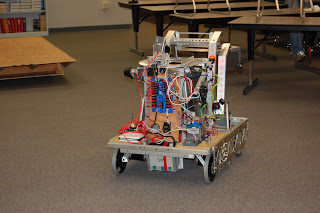Based on a 30 lb repairs and upgrades rule, we withheld the Flinger (one of our various names for the shooting mechanism) in order to continue working on it. We encountered torque problems with the drive-train using only 2 CIM motors, so we changed to 4 on the drive-train. This means that we are no longer able to use a CIM motor on the Flinger (rules mandate no more than 4 CIMs on any one robot). Since bag n' tag we have been working on putting together a custom gearbox with inputs for up to 4 BaneBots 550 motors in lieu of a CIM. The likelihood that we will require all 4 to achieve the power we want in the Flinger is low. More likely we will end up using 2 or 3, however due to the incredible torque of the BB550, and our gearing down it may be possible to achieve the results we require with only 1 motor. Isaac Lozano was in charge of that project, and I helped out some when he wasn't around. Since then most of the parts have been fabricated, and we met for a small group session on Sunday with half a dozen of the mechanical team to get a good idea of what will be happening on the project, and prepare for it.
Since I last logged anything I worked on pneumatics for a short period (I was in charge of that subsystem), many mechanical people worked on the disaster that ending up not being tank treads. We had too many last-minute problems to deal with and ended up switching to wheels. A couple of impressive notes on that however, are that 1) we were able to switch drive modules from one side to another reversing the entire drive-train in about an hour. 2) we were able to change from treads to wheels in about an hour as well. These are both rather in-depth processes, and the fact that we were able to do them so painlessly speaks to the advantageous nature of the modular construction of our drive-train this year. I am currently working on the polycarbonate shield that wraps around the back of the robot, several things less robot-build-oriented such as planning of the pit for competition and putting together lists and forms for scouting other teams at competition. Scouting is a crucial, often over-looked among rookie teams, aspect of competition due to the complexity and spontaneity of FRC. As I discussed in the beginning of the season, matches consist of 2 alliances, each of which are made up of 3 teams (each with one robot). This means that from match to match, your alliance, and therefore the robots you are paired with and the strengths thereof change. A completely new match strategy must be designed based on robot and team strengths and weaknesses, as often as every 45 minutes during the tournament.
This is a picture of the robot on February 12th, things slowly coming together. In this picture one can see alligator clips attached to the motor powering the arm/scoop/appendage; we had been testing the functionality of the arm for the first time just that evening.
Here is a picture of the robot in action, the night of bagging. The programming and drive teams were getting one feverish night of practice in before the bot was sealed away.
Another shot of the bot in action, with the arm up in this one. The electronics boards are also visible from this viewpoint.



No comments:
Post a Comment